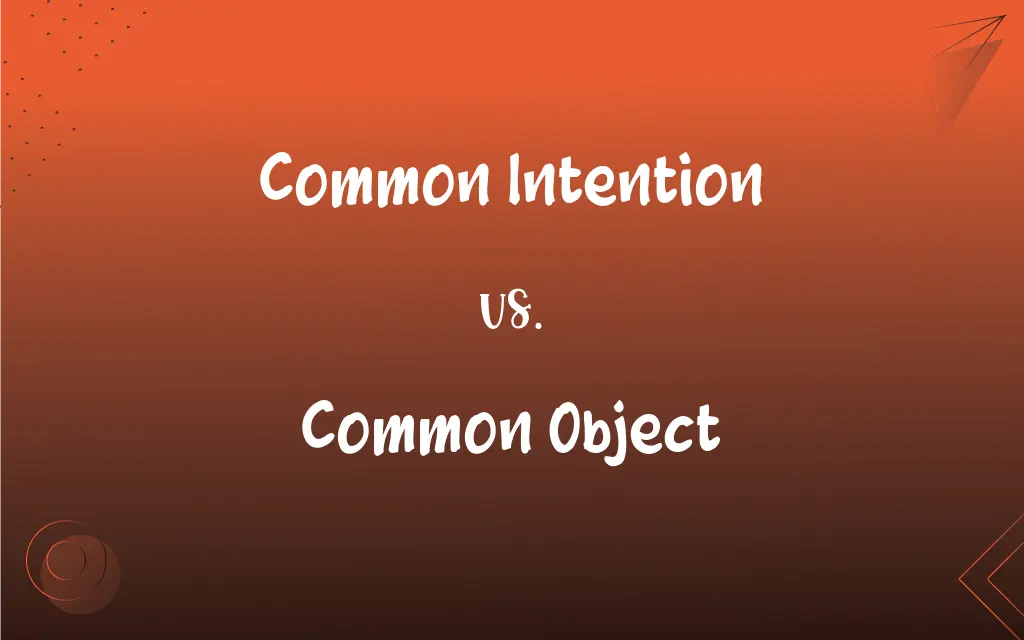Common Intention vs. Common Object: What's the Difference?
Edited by Aimie Carlson || By Janet White || Updated on November 28, 2023
Common intention refers to the shared mental plan or purpose among individuals, while common object is the collective physical goal or aim that a group strives to achieve.

Key Differences
Common intention involves a shared mental understanding or agreement among individuals to pursue a particular course of action. It signifies a collective mindset or plan. In contrast, common object refers to a tangible goal or target that a group aims to achieve, focusing more on the physical or practical outcome of the shared intention.
In the context of law, common intention often implies a prearranged plan among parties, indicating a collaborative mindset for a specific act. Common object, however, is oriented towards the end result or goal that this group intends to accomplish, which is usually concrete and observable.
Common intention is about the unity of thought and purpose, highlighting the psychological element of group dynamics. It's about the ‘why’ behind actions. On the other hand, common object is about the ‘what’ – the specific goal or outcome that the group is working towards, which is often tangible.
Establishing common intention can be crucial in legal scenarios where the motive or purpose behind a collective action is under scrutiny. Whereas, identifying the common object is key in determining the collective aim and the extent of the commitment towards a tangible goal.
Common intention and common object, while often related, differ in their focus; the former on the shared mental resolve and the latter on the collective physical aim or goal of a group's action.
ADVERTISEMENT
Comparison Chart
Nature
Mental plan or purpose shared among individuals.
Physical goal or aim pursued by a group.
Context
Psychological element of group dynamics.
Tangible outcome or result of collective action.
Legal Relevance
Focuses on motive and planning in legal cases.
Centers on the physical goal in legal scenarios.
Key Element
Unity of thought and purpose.
Unity in achieving a specific, tangible outcome.
Application
Important in assessing collective mindset.
Crucial in evaluating the group's target goal.
ADVERTISEMENT
Common Intention and Common Object Definitions
Common Intention
Shared mental purpose among individuals.
Their common intention was to promote environmental awareness.
Common Object
Specific outcome or result aimed by a group.
The protesters' common object was to enact legislative change.
Common Intention
Unity of thought and purpose in a collective action.
They had a common intention to support community development.
Common Object
Concretely defined goal of group action.
The team's common object was to win the championship.
Common Intention
Joint mindset towards a specific course of action.
Their common intention was to achieve academic excellence.
Common Object
Tangible aim pursued collectively.
The committee's common object was to organize a successful fundraiser.
Common Intention
Collective plan or agreement within a group.
The team's common intention was to innovate in technology.
Common Object
Collective physical goal of a group.
Their common object was to build a community center.
Common Intention
Collaborative mental resolve among parties.
The activists shared a common intention to advocate for human rights.
Common Object
Physical target of a group's collective effort.
Their common object was the restoration of the historic park.
FAQs
Is common intention legally binding?
It depends on the context; in some legal situations, common intention can have contractual or criminal implications.
Can common intention be implied?
Yes, common intention can be implied from actions or circumstances, without being explicitly stated.
What is an example of common intention?
Planning a surprise party together is an example of common intention.
How is common intention different from common object?
Common intention is about a shared mental plan or purpose, while common object is more about a physical goal or item that a group aims to achieve or obtain.
What role does common intention play in contract law?
In contract law, common intention can determine the understanding and agreement between parties.
Can common object involve intangible items?
Yes, it can involve intangible items like rights or privileges.
How is common intention proven in court?
Through evidence like communications, actions, and the context of the situation.
What is common intention?
Common intention refers to a shared plan or purpose held by two or more people.
What is an example of common object?
A group of people working together to protect a community park.
Can common intention and common object overlap?
Yes, they often do, especially in group settings where the intention leads to a physical objective.
How important is the common object in group dynamics?
Very important; it often defines the group’s activities and decisions.
How does common intention affect group behavior?
It aligns actions and decisions towards a shared goal, influencing group dynamics.
How is common object determined in a group?
Through mutual agreement, discussion, or sometimes naturally through shared interests.
Can there be a conflict between common intention and common object?
Yes, especially if the intended means differ from the desired end.
Are common intention and common object important in sociology?
Yes, they are key concepts in understanding group behavior and social dynamics.
What is a common object in legal terms?
In legal terms, a common object often refers to a shared physical goal or item that a group seeks, like property in a dispute.
Do businesses use the concept of common intention?
Yes, businesses often rely on common intention for teamwork and project planning.
How does common intention relate to collective responsibility?
Common intention can lead to collective responsibility, especially in situations where a group acts together towards a shared goal.
Can common intention change over time?
Yes, as circumstances and people’s thoughts evolve, their common intention can change.
Is a common object always tangible?
No, it can be intangible, like achieving a certain status or goal.
About Author
Written by
Janet WhiteJanet White has been an esteemed writer and blogger for Difference Wiki. Holding a Master's degree in Science and Medical Journalism from the prestigious Boston University, she has consistently demonstrated her expertise and passion for her field. When she's not immersed in her work, Janet relishes her time exercising, delving into a good book, and cherishing moments with friends and family.
Edited by
Aimie CarlsonAimie Carlson, holding a master's degree in English literature, is a fervent English language enthusiast. She lends her writing talents to Difference Wiki, a prominent website that specializes in comparisons, offering readers insightful analyses that both captivate and inform.






































































